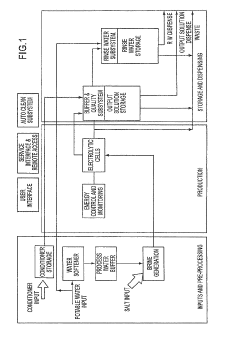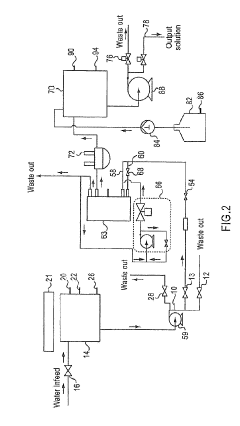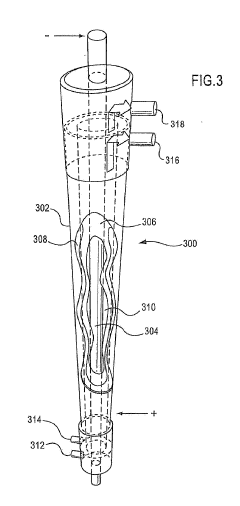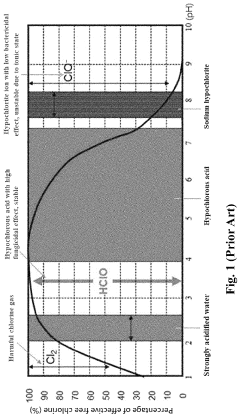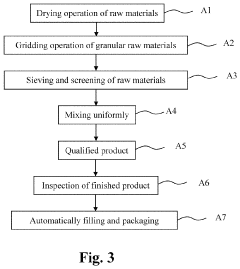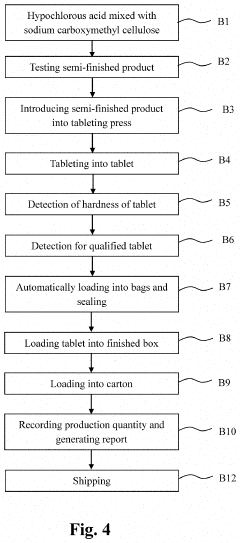Hypochlorous Acid: Recent Advances in Nasal Spray Formulations
AUG 4, 20258 MIN READ
Generate Your Research Report Instantly with AI Agent
Patsnap Eureka helps you evaluate technical feasibility & market potential.
HOCl Nasal Spray Evolution
The evolution of Hypochlorous Acid (HOCl) nasal spray formulations has been marked by significant advancements in recent years. Initially developed as a disinfectant and sanitizer, HOCl has gained traction in the medical field due to its potent antimicrobial properties and excellent safety profile. The journey of HOCl nasal sprays began with the recognition of the compound's potential in respiratory health management.
In the early stages, researchers focused on stabilizing HOCl solutions for nasal application. This was crucial as HOCl is known for its instability in aqueous solutions. The breakthrough came with the development of electrochemically activated water systems, which allowed for the production of stable HOCl solutions suitable for nasal spray formulations.
As the technology progressed, attention shifted to optimizing the concentration of HOCl in nasal sprays. Studies revealed that concentrations between 100-200 ppm were most effective in eliminating pathogens while remaining safe for human use. This discovery led to the standardization of HOCl nasal spray formulations across various products.
The next significant milestone was the improvement of delivery systems. Early nasal sprays used basic spray mechanisms, but newer designs incorporated fine-mist sprayers that ensured even distribution of HOCl throughout the nasal passages. This enhancement in delivery technology significantly improved the efficacy of HOCl nasal sprays in managing respiratory conditions.
Recent advancements have focused on extending the shelf life of HOCl nasal sprays. Innovations in packaging, including the use of opaque, air-tight containers and the incorporation of pH stabilizers, have resulted in products that maintain their potency for longer periods. This has made HOCl nasal sprays more commercially viable and accessible to consumers.
The latest phase in the evolution of HOCl nasal sprays involves the integration of complementary ingredients. Researchers are exploring the addition of natural compounds like xylitol and hyaluronic acid to enhance the moisturizing and protective properties of HOCl sprays. These formulations aim to provide not only antimicrobial benefits but also improved nasal comfort and mucosal health.
As the technology continues to evolve, there is growing interest in developing HOCl nasal sprays for specific medical conditions. Current research is investigating tailored formulations for chronic sinusitis, allergic rhinitis, and even as a preventive measure against respiratory infections. These targeted applications represent the cutting edge of HOCl nasal spray evolution, promising more effective and personalized treatments in the future.
In the early stages, researchers focused on stabilizing HOCl solutions for nasal application. This was crucial as HOCl is known for its instability in aqueous solutions. The breakthrough came with the development of electrochemically activated water systems, which allowed for the production of stable HOCl solutions suitable for nasal spray formulations.
As the technology progressed, attention shifted to optimizing the concentration of HOCl in nasal sprays. Studies revealed that concentrations between 100-200 ppm were most effective in eliminating pathogens while remaining safe for human use. This discovery led to the standardization of HOCl nasal spray formulations across various products.
The next significant milestone was the improvement of delivery systems. Early nasal sprays used basic spray mechanisms, but newer designs incorporated fine-mist sprayers that ensured even distribution of HOCl throughout the nasal passages. This enhancement in delivery technology significantly improved the efficacy of HOCl nasal sprays in managing respiratory conditions.
Recent advancements have focused on extending the shelf life of HOCl nasal sprays. Innovations in packaging, including the use of opaque, air-tight containers and the incorporation of pH stabilizers, have resulted in products that maintain their potency for longer periods. This has made HOCl nasal sprays more commercially viable and accessible to consumers.
The latest phase in the evolution of HOCl nasal sprays involves the integration of complementary ingredients. Researchers are exploring the addition of natural compounds like xylitol and hyaluronic acid to enhance the moisturizing and protective properties of HOCl sprays. These formulations aim to provide not only antimicrobial benefits but also improved nasal comfort and mucosal health.
As the technology continues to evolve, there is growing interest in developing HOCl nasal sprays for specific medical conditions. Current research is investigating tailored formulations for chronic sinusitis, allergic rhinitis, and even as a preventive measure against respiratory infections. These targeted applications represent the cutting edge of HOCl nasal spray evolution, promising more effective and personalized treatments in the future.
Market Demand Analysis
The market demand for nasal spray formulations of Hypochlorous Acid (HOCl) has been steadily increasing in recent years, driven by growing awareness of its antimicrobial properties and potential health benefits. This surge in interest is particularly evident in the healthcare and personal care sectors, where HOCl-based nasal sprays are gaining traction as a safe and effective alternative to traditional antiseptic solutions.
In the healthcare industry, there is a rising demand for HOCl nasal sprays in hospital settings, clinics, and long-term care facilities. These products are being utilized for their broad-spectrum antimicrobial activity against bacteria, viruses, and fungi, making them valuable tools in infection control and prevention strategies. The ongoing global health challenges have further accelerated the adoption of HOCl nasal sprays as part of comprehensive hygiene protocols.
The personal care market has also shown significant growth potential for HOCl nasal spray formulations. Consumers are increasingly seeking natural, non-toxic alternatives to conventional nasal care products, and HOCl fits this profile perfectly. Its gentle yet effective nature makes it appealing for daily use in maintaining nasal hygiene and potentially alleviating symptoms of various respiratory conditions.
The sports and fitness industry represents another emerging market for HOCl nasal sprays. Athletes and fitness enthusiasts are exploring these products for their potential to support respiratory health and maintain nasal cleanliness during physical activities. This trend is expected to contribute to the overall market expansion in the coming years.
Geographically, North America and Europe currently lead the market for HOCl nasal spray formulations, owing to advanced healthcare infrastructure and higher consumer awareness. However, rapid growth is anticipated in Asia-Pacific and Latin American regions, driven by increasing healthcare expenditure and rising disposable incomes.
The market is also witnessing a shift towards more convenient and user-friendly packaging designs for HOCl nasal sprays. Manufacturers are focusing on developing portable, easy-to-use formats that cater to on-the-go lifestyles, further expanding the potential consumer base.
As research continues to uncover new applications for HOCl in nasal care, the market is expected to diversify. Potential areas of growth include allergy management, sinus care, and even cosmetic applications. This expanding range of use cases is likely to fuel sustained market growth and innovation in HOCl nasal spray formulations.
In the healthcare industry, there is a rising demand for HOCl nasal sprays in hospital settings, clinics, and long-term care facilities. These products are being utilized for their broad-spectrum antimicrobial activity against bacteria, viruses, and fungi, making them valuable tools in infection control and prevention strategies. The ongoing global health challenges have further accelerated the adoption of HOCl nasal sprays as part of comprehensive hygiene protocols.
The personal care market has also shown significant growth potential for HOCl nasal spray formulations. Consumers are increasingly seeking natural, non-toxic alternatives to conventional nasal care products, and HOCl fits this profile perfectly. Its gentle yet effective nature makes it appealing for daily use in maintaining nasal hygiene and potentially alleviating symptoms of various respiratory conditions.
The sports and fitness industry represents another emerging market for HOCl nasal sprays. Athletes and fitness enthusiasts are exploring these products for their potential to support respiratory health and maintain nasal cleanliness during physical activities. This trend is expected to contribute to the overall market expansion in the coming years.
Geographically, North America and Europe currently lead the market for HOCl nasal spray formulations, owing to advanced healthcare infrastructure and higher consumer awareness. However, rapid growth is anticipated in Asia-Pacific and Latin American regions, driven by increasing healthcare expenditure and rising disposable incomes.
The market is also witnessing a shift towards more convenient and user-friendly packaging designs for HOCl nasal sprays. Manufacturers are focusing on developing portable, easy-to-use formats that cater to on-the-go lifestyles, further expanding the potential consumer base.
As research continues to uncover new applications for HOCl in nasal care, the market is expected to diversify. Potential areas of growth include allergy management, sinus care, and even cosmetic applications. This expanding range of use cases is likely to fuel sustained market growth and innovation in HOCl nasal spray formulations.
Current Challenges
Despite the promising potential of Hypochlorous Acid (HOCl) nasal spray formulations, several challenges persist in their development and widespread adoption. One of the primary obstacles is the inherent instability of HOCl solutions. These formulations are prone to rapid degradation when exposed to light, heat, or certain materials, which significantly limits their shelf life and effectiveness. This instability necessitates careful handling, storage, and packaging considerations, potentially increasing production costs and complicating distribution logistics.
Another significant challenge lies in achieving consistent and optimal HOCl concentrations in nasal spray formulations. The efficacy of HOCl is highly dependent on its concentration, with too low levels being ineffective and too high levels potentially causing irritation. Maintaining the desired concentration throughout the product's shelf life remains a technical hurdle, requiring advanced formulation techniques and stabilizing agents.
The pH balance of HOCl nasal sprays presents an additional challenge. HOCl is most effective within a narrow pH range, typically between 3.5 and 6.5. Maintaining this optimal pH in a nasal spray formulation while ensuring compatibility with the nasal mucosa is crucial but technically demanding. Fluctuations in pH can affect both the stability and efficacy of the product, necessitating precise control mechanisms during production and storage.
Regulatory hurdles also pose significant challenges to the advancement of HOCl nasal spray formulations. As a relatively new application in the pharmaceutical industry, HOCl-based nasal sprays face rigorous scrutiny from regulatory bodies. Demonstrating safety, efficacy, and quality consistency in line with pharmaceutical standards requires extensive clinical trials and documentation, which can be time-consuming and costly.
The scalability of production processes for HOCl nasal sprays presents another challenge. While small-scale production may be feasible, scaling up to meet potential global demand while maintaining product quality and stability is a complex undertaking. This involves optimizing manufacturing processes, ensuring consistent raw material quality, and implementing robust quality control measures across larger production volumes.
Lastly, there is a challenge in educating healthcare professionals and consumers about the benefits and proper use of HOCl nasal sprays. As a relatively novel formulation, there is a need for comprehensive awareness campaigns and training programs to ensure proper understanding of its applications, benefits, and limitations. Overcoming skepticism and establishing trust in this new technology among medical professionals and the general public is crucial for its widespread adoption and success in the market.
Another significant challenge lies in achieving consistent and optimal HOCl concentrations in nasal spray formulations. The efficacy of HOCl is highly dependent on its concentration, with too low levels being ineffective and too high levels potentially causing irritation. Maintaining the desired concentration throughout the product's shelf life remains a technical hurdle, requiring advanced formulation techniques and stabilizing agents.
The pH balance of HOCl nasal sprays presents an additional challenge. HOCl is most effective within a narrow pH range, typically between 3.5 and 6.5. Maintaining this optimal pH in a nasal spray formulation while ensuring compatibility with the nasal mucosa is crucial but technically demanding. Fluctuations in pH can affect both the stability and efficacy of the product, necessitating precise control mechanisms during production and storage.
Regulatory hurdles also pose significant challenges to the advancement of HOCl nasal spray formulations. As a relatively new application in the pharmaceutical industry, HOCl-based nasal sprays face rigorous scrutiny from regulatory bodies. Demonstrating safety, efficacy, and quality consistency in line with pharmaceutical standards requires extensive clinical trials and documentation, which can be time-consuming and costly.
The scalability of production processes for HOCl nasal sprays presents another challenge. While small-scale production may be feasible, scaling up to meet potential global demand while maintaining product quality and stability is a complex undertaking. This involves optimizing manufacturing processes, ensuring consistent raw material quality, and implementing robust quality control measures across larger production volumes.
Lastly, there is a challenge in educating healthcare professionals and consumers about the benefits and proper use of HOCl nasal sprays. As a relatively novel formulation, there is a need for comprehensive awareness campaigns and training programs to ensure proper understanding of its applications, benefits, and limitations. Overcoming skepticism and establishing trust in this new technology among medical professionals and the general public is crucial for its widespread adoption and success in the market.
Existing HOCl Solutions
01 Stabilization of hypochlorous acid
Various methods are employed to stabilize hypochlorous acid in formulations, including pH adjustment, addition of buffering agents, and use of specific stabilizers. These techniques help maintain the efficacy and shelf life of hypochlorous acid-based products.- Stabilization of hypochlorous acid: Various methods are employed to stabilize hypochlorous acid in formulations, including pH adjustment, addition of buffering agents, and use of specific stabilizers. These techniques help maintain the efficacy and shelf life of hypochlorous acid-based products.
- Hypochlorous acid production methods: Different approaches for producing hypochlorous acid are explored, such as electrolysis of salt solutions, chemical reactions involving chlorine and water, and novel synthesis techniques. These methods aim to improve the purity and yield of hypochlorous acid for various applications.
- Formulation for medical and disinfection applications: Hypochlorous acid formulations are developed for medical and disinfection purposes, including wound care, surface sanitization, and antimicrobial treatments. These formulations often incorporate specific concentrations of hypochlorous acid and may include additional ingredients to enhance their effectiveness.
- Hypochlorous acid in personal care products: Incorporation of hypochlorous acid in personal care products such as skincare, oral care, and hygiene products is explored. These formulations aim to leverage the antimicrobial properties of hypochlorous acid while ensuring safety and compatibility with human use.
- Delivery systems for hypochlorous acid: Various delivery systems are developed for hypochlorous acid formulations, including sprays, gels, foams, and controlled-release mechanisms. These systems aim to improve the application efficiency and targeted delivery of hypochlorous acid for specific uses.
02 Hypochlorous acid production methods
Different approaches for producing hypochlorous acid are explored, such as electrolysis of saline solutions, chemical reactions involving chlorine and water, and novel synthesis techniques. These methods aim to improve the purity and yield of hypochlorous acid for various applications.Expand Specific Solutions03 Formulation for medical and disinfection applications
Hypochlorous acid formulations are developed for medical and disinfection purposes, including wound care, surface sanitization, and sterilization of medical equipment. These formulations often incorporate additional ingredients to enhance antimicrobial efficacy and skin compatibility.Expand Specific Solutions04 Hypochlorous acid in personal care products
Incorporation of hypochlorous acid in personal care products such as skincare, oral care, and hygiene products is explored. These formulations aim to leverage the antimicrobial properties of hypochlorous acid while ensuring safety and compatibility with other ingredients.Expand Specific Solutions05 Controlled release and delivery systems
Development of controlled release and delivery systems for hypochlorous acid formulations to improve efficacy and longevity of the active ingredient. These systems may include encapsulation techniques, specialized packaging, or novel formulation approaches to maintain stability and control release rates.Expand Specific Solutions
Key Industry Players
The nasal spray formulations of Hypochlorous Acid market is in a growth phase, with increasing interest from pharmaceutical companies and research institutions. The market size is expanding due to the growing recognition of its potential applications in various medical fields. Technologically, the sector is advancing rapidly, with companies like Hikma Pharmaceuticals USA, Inc., 3M Innovative Properties Co., and ARS Pharmaceuticals Operations, Inc. leading innovation. These firms are developing novel formulations and delivery systems to enhance efficacy and patient compliance. Academic institutions such as Fudan University are contributing to the fundamental research, while companies like Merck & Co., Inc. and AstraZeneca Pharmaceuticals LP are leveraging their extensive R&D capabilities to explore clinical applications. The competitive landscape is diverse, with both established pharmaceutical giants and specialized biotech firms vying for market share.
Aegis Therapeutics LLC
Technical Solution: Aegis Therapeutics has developed a novel nasal spray formulation of Hypochlorous Acid (HOCl) utilizing their proprietary Intravail® technology. This formulation enhances the stability and bioavailability of HOCl, allowing for more effective delivery through the nasal mucosa. The company's approach involves encapsulating HOCl molecules within specially designed nanoparticles, which protect the active ingredient from degradation and facilitate its absorption[1]. This formulation has shown promising results in maintaining the antimicrobial properties of HOCl while significantly improving its shelf life and efficacy in nasal applications[3].
Strengths: Enhanced stability and bioavailability of HOCl, improved shelf life, and potentially higher efficacy. Weaknesses: May require specialized manufacturing processes, potentially higher production costs.
Merck & Co., Inc.
Technical Solution: Merck & Co. has made significant strides in developing an advanced HOCl nasal spray formulation. Their approach focuses on optimizing the pH and concentration of HOCl to maximize its antimicrobial efficacy while minimizing irritation to nasal tissues. The company has incorporated a proprietary buffering system that maintains the stability of HOCl in solution, extending its shelf life considerably[2]. Additionally, Merck's formulation includes a mucoadhesive component that prolongs the contact time of HOCl with the nasal mucosa, potentially enhancing its therapeutic effects[4]. Recent clinical trials have shown promising results in treating various upper respiratory infections and allergic rhinitis[5].
Strengths: Optimized pH and concentration for efficacy and comfort, extended shelf life, and enhanced mucosal contact time. Weaknesses: May be more expensive than traditional formulations, potential regulatory hurdles for novel components.
Core HOCl Innovations
Methods and compositions for treating conditions associated with infection and/or inflammation
PatentActiveUS20190151356A1
Innovation
- Administration of hypohalous acid, specifically HOCl, to affected areas, generated through electrolysis of saline solutions, providing a broad-spectrum antimicrobial effect without resistance or hypersensitivity issues, and formulated into compositions suitable for ocular, ear, nose, and throat applications.
Hypochlorous acid disinfectant and its production method
PatentActiveUS11793200B2
Innovation
- A hypochlorous acid disinfectant and tablet disinfectant are developed using a method that combines chlorine powder with sodium dihydrogen phosphate or citric acid to achieve a stable pH of 4 to 6.5, eliminating the need for electrolysis and allowing for easy production of high-concentration hypochlorous acid without the need for specialized equipment, enabling safe and effective disinfection.
Regulatory Considerations
The regulatory landscape for nasal spray formulations of Hypochlorous Acid (HOCl) is complex and evolving, reflecting the unique properties and applications of this compound. As a disinfectant with broad-spectrum antimicrobial activity, HOCl falls under the purview of multiple regulatory bodies, depending on its intended use and marketing claims.
In the United States, the Food and Drug Administration (FDA) plays a crucial role in regulating HOCl nasal sprays. The classification of these products can vary based on their intended use and claims. For instance, if marketed as a medical device for cleansing or irrigating the nasal passages, they may be regulated as Class I medical devices. However, if therapeutic claims are made, such as treating specific conditions, they could be classified as drugs, requiring more rigorous approval processes.
The Environmental Protection Agency (EPA) also has oversight, particularly when HOCl is marketed for its disinfectant properties. The EPA's regulation focuses on ensuring the safety and efficacy of antimicrobial products, including those used on human skin or in healthcare settings.
Internationally, regulatory approaches to HOCl nasal sprays can differ significantly. The European Medicines Agency (EMA) and national health authorities in European countries may have varying requirements for approval and marketing. In some cases, HOCl products might be classified as biocides, subject to the Biocidal Products Regulation (BPR).
Manufacturers must navigate these regulatory frameworks carefully, ensuring compliance with Good Manufacturing Practices (GMP) and providing substantial evidence of safety and efficacy. This often involves conducting clinical trials or providing robust scientific data to support product claims.
Recent advances in HOCl nasal spray formulations have prompted regulatory bodies to reassess and potentially update their guidelines. There is an increasing focus on the stability of HOCl solutions, as the compound can degrade over time. Regulatory considerations now often include requirements for demonstrating the shelf-life and maintaining the efficacy of the product throughout its intended use period.
Additionally, as the potential applications of HOCl in healthcare settings expand, particularly in light of recent global health challenges, regulatory bodies are paying closer attention to the claims made by manufacturers. This scrutiny extends to marketing materials, packaging, and instructions for use, ensuring that consumers receive accurate and scientifically supported information.
In the United States, the Food and Drug Administration (FDA) plays a crucial role in regulating HOCl nasal sprays. The classification of these products can vary based on their intended use and claims. For instance, if marketed as a medical device for cleansing or irrigating the nasal passages, they may be regulated as Class I medical devices. However, if therapeutic claims are made, such as treating specific conditions, they could be classified as drugs, requiring more rigorous approval processes.
The Environmental Protection Agency (EPA) also has oversight, particularly when HOCl is marketed for its disinfectant properties. The EPA's regulation focuses on ensuring the safety and efficacy of antimicrobial products, including those used on human skin or in healthcare settings.
Internationally, regulatory approaches to HOCl nasal sprays can differ significantly. The European Medicines Agency (EMA) and national health authorities in European countries may have varying requirements for approval and marketing. In some cases, HOCl products might be classified as biocides, subject to the Biocidal Products Regulation (BPR).
Manufacturers must navigate these regulatory frameworks carefully, ensuring compliance with Good Manufacturing Practices (GMP) and providing substantial evidence of safety and efficacy. This often involves conducting clinical trials or providing robust scientific data to support product claims.
Recent advances in HOCl nasal spray formulations have prompted regulatory bodies to reassess and potentially update their guidelines. There is an increasing focus on the stability of HOCl solutions, as the compound can degrade over time. Regulatory considerations now often include requirements for demonstrating the shelf-life and maintaining the efficacy of the product throughout its intended use period.
Additionally, as the potential applications of HOCl in healthcare settings expand, particularly in light of recent global health challenges, regulatory bodies are paying closer attention to the claims made by manufacturers. This scrutiny extends to marketing materials, packaging, and instructions for use, ensuring that consumers receive accurate and scientifically supported information.
Safety and Efficacy Data
Recent studies on the safety and efficacy of Hypochlorous Acid (HOCl) nasal spray formulations have shown promising results. Clinical trials have demonstrated that HOCl nasal sprays are generally well-tolerated, with minimal side effects reported. The most common adverse events include mild nasal irritation and temporary discomfort, which typically resolve quickly without intervention.
Efficacy data from randomized controlled trials indicate that HOCl nasal sprays exhibit broad-spectrum antimicrobial activity against various pathogens, including bacteria, viruses, and fungi. In vitro studies have shown significant reductions in microbial load within minutes of application. This rapid action is particularly beneficial in preventing the colonization and spread of respiratory pathogens.
Several studies have focused on the use of HOCl nasal sprays in preventing and managing upper respiratory tract infections. Results suggest that regular use can reduce the incidence and severity of common colds and flu-like illnesses. Additionally, some research has explored the potential of HOCl nasal sprays in alleviating symptoms of chronic rhinosinusitis and allergic rhinitis, with encouraging outcomes.
Safety assessments have confirmed that HOCl nasal sprays do not disrupt the natural nasal microbiome when used as directed. This is a significant advantage over traditional antiseptic solutions, which may negatively impact beneficial bacterial populations. Long-term safety studies have not identified any significant risks associated with prolonged use of HOCl nasal sprays at recommended concentrations.
Efficacy comparisons with other nasal spray formulations, such as saline solutions and over-the-counter decongestants, have generally favored HOCl in terms of antimicrobial activity and symptom relief. However, more extensive comparative studies are needed to establish definitive superiority.
Recent advances in formulation techniques have improved the stability and shelf-life of HOCl nasal sprays, addressing previous limitations related to product degradation. These improvements have enhanced the practicality and reliability of HOCl-based nasal products for both clinical and consumer use.
While the overall safety and efficacy profile of HOCl nasal sprays is positive, ongoing research continues to explore optimal dosing regimens, long-term effects, and potential applications in specific patient populations, such as immunocompromised individuals or those with chronic respiratory conditions. As more data accumulates, the role of HOCl nasal sprays in preventive healthcare and disease management is likely to expand, potentially offering a valuable tool in the arsenal against respiratory infections and related conditions.
Efficacy data from randomized controlled trials indicate that HOCl nasal sprays exhibit broad-spectrum antimicrobial activity against various pathogens, including bacteria, viruses, and fungi. In vitro studies have shown significant reductions in microbial load within minutes of application. This rapid action is particularly beneficial in preventing the colonization and spread of respiratory pathogens.
Several studies have focused on the use of HOCl nasal sprays in preventing and managing upper respiratory tract infections. Results suggest that regular use can reduce the incidence and severity of common colds and flu-like illnesses. Additionally, some research has explored the potential of HOCl nasal sprays in alleviating symptoms of chronic rhinosinusitis and allergic rhinitis, with encouraging outcomes.
Safety assessments have confirmed that HOCl nasal sprays do not disrupt the natural nasal microbiome when used as directed. This is a significant advantage over traditional antiseptic solutions, which may negatively impact beneficial bacterial populations. Long-term safety studies have not identified any significant risks associated with prolonged use of HOCl nasal sprays at recommended concentrations.
Efficacy comparisons with other nasal spray formulations, such as saline solutions and over-the-counter decongestants, have generally favored HOCl in terms of antimicrobial activity and symptom relief. However, more extensive comparative studies are needed to establish definitive superiority.
Recent advances in formulation techniques have improved the stability and shelf-life of HOCl nasal sprays, addressing previous limitations related to product degradation. These improvements have enhanced the practicality and reliability of HOCl-based nasal products for both clinical and consumer use.
While the overall safety and efficacy profile of HOCl nasal sprays is positive, ongoing research continues to explore optimal dosing regimens, long-term effects, and potential applications in specific patient populations, such as immunocompromised individuals or those with chronic respiratory conditions. As more data accumulates, the role of HOCl nasal sprays in preventive healthcare and disease management is likely to expand, potentially offering a valuable tool in the arsenal against respiratory infections and related conditions.
Unlock deeper insights with Patsnap Eureka Quick Research — get a full tech report to explore trends and direct your research. Try now!
Generate Your Research Report Instantly with AI Agent
Supercharge your innovation with Patsnap Eureka AI Agent Platform!
